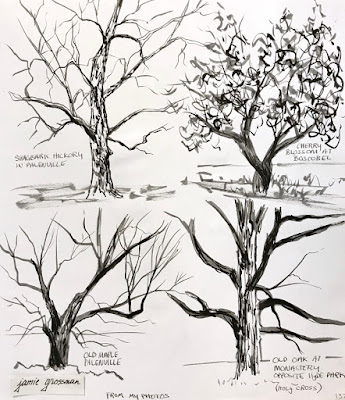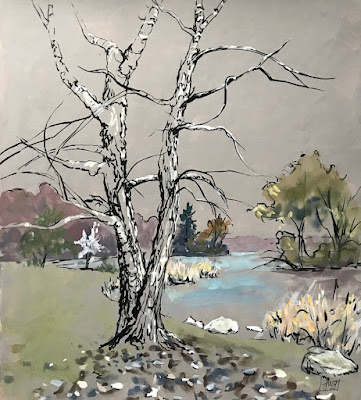Gouache on black paper
Painted from life in Trish's back yard
For landscape painters, being able to capture the character of a tree, or the silhouette of a distant tree line, is an important aspect of making a successful painting. Project Megasketch gifted me with ample time to study many different ways of drawing and painting these beautiful and graceful living structures. Toward the end of the project, I combined what I'd practiced with some experimental approaches. I hope this post inspires you to push forward with a favorite subject of your own to develop skills and style. It doesn't have to be trees!
Ink and wash, from one of my own photos
Some I sketched from my own reference photos, like the unique tree (above) that resides at the Bronx Zoo. I tried to keep in mind what I'd learned about tree contours in the time I'd spent with the online
lessons at DrawABox.com! (If you haven't gone through the lessons there, do it! You won't regret it. See my post on Lines, Ellipses and Perspective for a quick overview.)
Trees from my photo file, in ink
Tree at Olana from my photo references.
Cretacolor Monolith 6B pencil, Wolff's Carbon Pencil 6B, ArtGraf Carbon Black, Coliro Arabic Gold watercolor, Daniel Smith Iridescent Watercolor Medium, Schmincke Dry Gouache in Silver, Rich Gold, Rich Pale Gold, Copper, mixed with Da Vinci Watercolor Medium, Waterbrush
The trees outside your windows can provide you with a lot of reference material from life without having to go anywhere at all. (Below)
Sketching trees from my windows
Carbon Pencils, water brush, and Schmincke iridescent gouache powders mixed with gum arabic
One of the things that I found most effective was to look carefully at how artists I admired rendered trees. Since copyright laws protect works by other artists, the purely educational and non-commercial aspects of Project Megasketch give us a unique opportunity to study and copy those works. We can then explore how to incorporate some of those ideas when creating art from our own references and from life.
After Henry C. Pitz
Sketched from tree studies in his book
Viarco ArtGraf Carbon Black, waterbrush, Pentel Slicci .25
Henry Pitz wrote a book on trees that features work in many different drawing mediums. I worked from his book quite a bit during this project. Here's a link to the book on Amazon. I got mine used, and I see there are plenty of used copies available in both the hardcover and paperback.
Sketched from Frederick Garner's book, More Trees
Caran D'Ache Grand Canyon ink in a Pilot Petit 3 brush pen
Frederick Garner has a few books on drawing trees in the Walter Foster art book series. I had them on my shelf for over 30 years, and finally pulled them out to appreciate his style, and try to emulate some of it. (See above and below.)
Sketched from Frederick Garner's book More Trees
Kaweco Smokey Gray ink in Pilot Petit 3, Golden High Flow Indigo and a bit of Quinacridone Red in a Montana marker, Golden High Flow Shading Gray and Indigo with brushes
I found a lot of old botanical illustrations of trees online, and used those as a basis for some of my studies too. Adolphe Philippe Millot became one of my favorites. He was a French painter, lithographer and entomologist who did amazing illustration work.
Some of my watercolor sketches from Millot's tree illustrations
Often, I'd use a tree as a subject to experiment with new paints or techniques. The thing about doing something new and experimental is that there is always a high failure rate, so we tend to be reluctant to work outside of our own boxes. In Project Megasketch, since it was a non-commercial project, I was interested in learning and not in selling. I wondered what attracts artists to paint on colors like bright orange, and thought I'd see what it looked like if I toned two pages with bright orange, and then sketched some of Millot's illustrations in grays or subdued colors. Well, I found out, and it's NOT PRETTY! LOL
If you don't try, you won't know. Even though to me this is a failure as a "work of art", I still got the benefit of doing value studies with trees, and working from those gorgeous vintage references. And I learned that I'll leave the orange grounds to others from now on!
During the final 200 pages of Project Megasketch, I wanted to let loose with what I had learned in the first 400 pages, and combine it with my own style and varied media to experiment and make it more personal.
Cherry tree in bloom from my tree photos file
Watercolor, charcoal, iridescent watercolor
One of the ways I did that was to take the same reference, and sketch it in many different ways, or with different materials, always altering something to assess the differences in the results and application. (See sketch above and both sketches below.)
Watercolor and Gouache, with a bit of charcoal
Drawing or painting a series of the same subject is a process that has much to teach us -- sometimes in unexpected ways.
Gouache on paper primed with black gesso
Doing all those quick tree sketches, and experimenting with process and materials, led me to some interesting results. Some I liked and some I didn't, but the feeling of having so many options was wonderful!
Acrylic
The sketch directly above and the one below were done in acrylic from the same reference photo. One was painted and spattered just with brushes, while the other used some stencils for additional texture.
Acrylic
The sketch on black paper at the very top of this post is something I probably wouldn't have done while out painting on location if it hadn't been part of this project. I generally save experimentation for the studio. The one below was also a plein air experiment, on paper primed with gray acrylic paint mixed with gesso. These exploratory sketches yielded new ideas to chase and practice.
Plein air sketch
Ink and gouache on acrylic-primed paper
Giving yourself freedom to fail, and permission to take chances, are what lead us to new creative spaces. Failure is an important component of any experimental process. Each approach that sparks our interest will also take practice, time, and patience to be developed. Finding new directions is always inspiring. That excitement of discovery is one of the things I love most about art.
For an overview of Project Megasketch and what it entails, see this post.
To see all of the Megasketch posts, click here. The newest posts will be at the top.
I try to post Project Megasketch installments on Mondays, under the subject heading "Megasketch Monday", but I reserve the right to be late from time to time! ;)

















Great selection of experiments! Trees are indeed fascinating and your experimentation with backgrounds is informing. Thanks for posting. There are so many interesting trees in the Hudson Valley due to age and wind effects. And the recent ice storm!
ReplyDelete